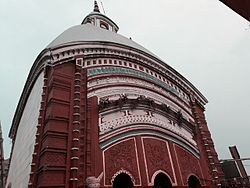Tarapith | |
|---|---|
Temple town | |
 Spire of Tarapith temple | |
| Coordinates: 24°07′N87°48′E / 24.11°N 87.80°E | |
| Country | |
| State | West Bengal |
| District | Birbhum |
| Population | |
• Total | 5,000 |
| Languages | |
| • Official | Bengali |
| Time zone | UTC+05:30 (IST) |
| Nearest city | Rampurhat |
Tarapith is a town and Hindu pilgrimage site located in Rampurhat subdivision of Birbhum district of the Indian state of West Bengal. The town is particularly known for the Tarapith Temple and its adjoining Hindu crematory ground. [1] The tantric Hindu temple is dedicated to the goddess Tara. [2] [3]
Contents
Tarapith is also famous for Tantric saint Bamakhepa, who worshipped in the temple and resided in the cremation grounds. [4] His ashram is also located in bank of Dwaraka river and close to the Tara temple. [5]
